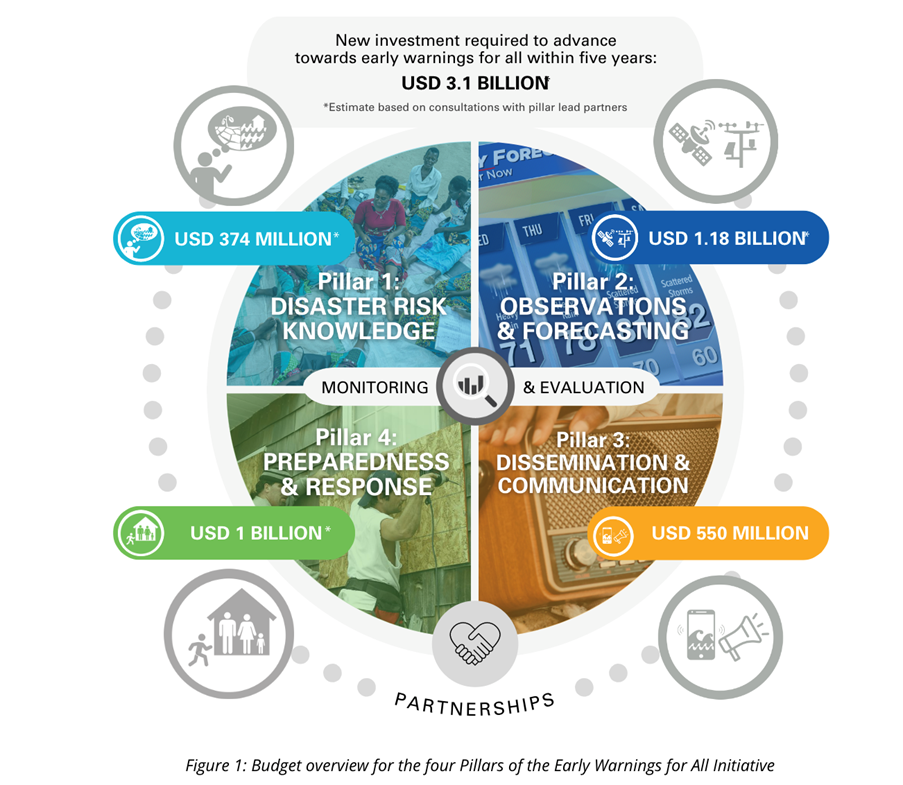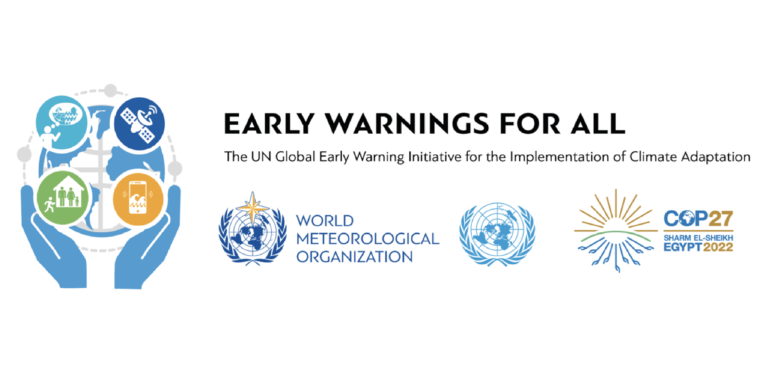United Nations secretary-general António Guterres has unveiled an ‘executive action plan’ for the Early Warnings for All initiative, calling for an initial targeted investment of US$3.1bn between 2023 and 2027. The investment would cover disaster risk knowledge, observations and forecasting, preparedness and response, and communication of early warnings.
Guterres announced the plan during the World Leaders Summit at COP 27. The plan was drawn up by the World Meteorological Organization (WMO) and partners, and is supported by a joint statement signed by 50 countries.
Speaking at the conference, Guterres said, “Ever-rising greenhouse gas emissions are supercharging extreme weather events across the planet. These increasing calamities cost lives and hundreds of billions of dollars in loss and damage. Three times more people are displaced by climate disasters than by war. Half of humanity is already in the danger zone.
“We must invest equally in adaptation and resilience. That includes the information that allows us to anticipate storms, heatwaves, floods and droughts. To that end, I have called for every person on Earth to be protected by early warning systems within five years, with the priority to support the most vulnerable first.”
The executive action plan sets out a way forward to achieve this goal. Half of all countries do not have early warning systems and even fewer have regulatory frameworks to link early warnings to emergency plans. Coverage is worst for developing countries on the front lines of climate change, namely least developed countries (LDCs) and small island developing states (SIDS).
Scientific advances
Early warning systems are widely regarded as the low-hanging fruit for climate change adaptation because they are a relatively cheap and effective way to protect people and assets from hazards, including storms, floods, heatwaves and tsunamis.
Prof. Petteri Taalas, WMO secretary-general, said, “Early warnings save lives and provide vast economic benefits. Just 24 hours’ notice of an impending hazardous event can cut the ensuing damage by 30%.”
The Global Commission on Adaptation found that spending US$800m on such systems in developing countries would avoid losses of US$3-16bn per year.
“Such progress is only possible with modern science, sustained systematic observing networks, daily international exchange of quality data, access to high-quality early warning products, the translation of forecasts into impacts, plus advances in telecommunications,” said Taalas.
According to the action plan, the essential ingredients to achieve Early Warnings for All include deeper understanding of risk across all timescales; stronger national meteorological and hydrological services, disaster risk management agencies and emergency preparedness measures; accessible financial and technical support, and an anticipatory humanitarian sector. A people-centered approach that prioritizes community engagement is also fundamental.
The Executive Action Plan 2023-2027 sets out the initial actions required to achieve the goal, as well as the pathway to implementation.
Sameh Hassan Shoukry, Egyptian minister of foreign affairs and COP 27 president, said, “The science is there and clearly shows the urgency with which we must act to assist those in need of support to adapt to the negative impacts of climate change. The launch of this executive action plan is an important contribution to adaptation and resilience, particularly in Africa, where 60% of people are not covered by early warning systems.”
EWS four pillars
The estimated new targeted investments of US$3.1bn over the five years would be used to advance the four key Multi-Hazard Early Warning System (MHEWS) pillars:
- Disaster risk knowledge (US$374m) – systematically collect data and undertake risk assessments on hazards and vulnerabilities;
- Observations and forecasting (US$1.18bn) – develop hazard monitoring and early warning services;
- Preparedness and response (US$1bn) – build national and community response capabilities;
- Dissemination and communication (US$550m) – communicate risk information so it reaches all those who need it, and is understandable and usable.
The plan identifies key areas for advancing universal disaster risk knowledge and outlines the priority actions required to achieve this, building on the Sendai Framework for Disaster Risk Reduction.
It prioritizes the top technical actions required to enhance capacity to detect hazards, close the observations gap, and advance global forecast data processing systems and data exchange, optimizing international efforts.
The plan indicates how key foundational financing mechanisms will be scaled up to support the achievement of the goal, including a new framework developed by the Climate Risk and Early Warning Systems (CREWS) Initiative and Green Climate Fund, and the operationalization of the Systematic Observations Financing Facility (SOFF).
The plan also calls for increased coherence and alignment of existing and planned investments from international financing institutions, utilizing the Alliance for Hydromet Development as an important uniting partnership of climate finance institutions.
The plan recognizes existing successful bilateral funds for early warnings and calls for an acceleration of these mechanisms. Tracking progress, informing decision making and measuring success are all key to ensuring effective implementation, so plans are outlined to develop an objective Early Warnings for All Maturity Index before COP 28.
To ensure progress and the continued strategic alignment of activities with implementing bodies, the United Nations secretary-general is creating an Early Warnings for All Governing Board, co-chaired by the executive heads of the WMO and the United Nations Office for Disaster Risk Reduction (UNDRR).
Board members will include many of the key partners who have shaped the executive action plan to date. The board will report annually on progress to the United Nations secretary-general in advance of the COP meetings.




